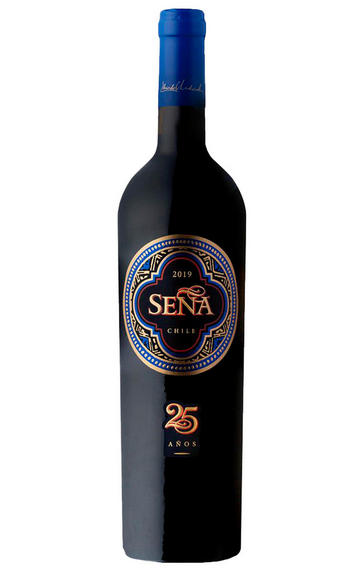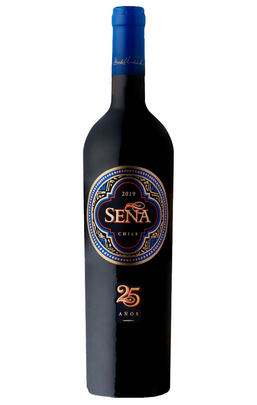
2019 Seña, Aconcagua Valley, Chile

Critics reviews
The 25th anniversary vintage, and an excellent showcase of the supple, nuanced fruits of this wine. Plenty of black cherry and bilberry puree, pure but layered. It has the rich depths that always delivers, where things are almost too much and yet not quite enough, still leaving you wanting more. Fragrant raspberry leaf becomes clearer as it opens in the glass, as does the saline minerality and a smoky finish, with the tannins becoming more delicate by the minute, highlighting freshness and juice. Located in the Aconguacgua foothills, following biodynamic farming. Tasted twice.
Drink 2024 - 2040
Jane Anson, JaneAnson.com (October 2021)
The 2019 Seña was produced with a Bordeaux blend of 60% Cabernet Sauvignon, 21% Malbec, 15% Carmenere and 4% Petit Verdot with the Chilean character of the high percentage of Carmenere. Most of the volume fermented in stainless steel with some 10% in concrete vats, and the final blend matured for 22 months in French oak barrels, 80% of them new, and 10% in Stockinger vats.
It's 13.5% alcohol and has good acidity and freshness, coming through as medium-bodied, elegant and balanced. This is incredibly elegant, subtle and harmonious even at this early stage. It has floral aromas, notes of orange peel, a touch of creamy sweet spices and great freshness. The palate is medium-bodied, seamless and pure, with pungent flavors and a soft texture. It's long, clean, defined and super tasty.
I feel this wine is getting better and better by the vintage.The grapes were picked quite early, and that helped to contain the ripeness and seems to have been a great decision. There was also an exception in the Panquehue zone where the Seña vines are, where the summer was cooler than the average, so quite different to many other regions in Chile. 100,000 bottles produced. It was bottled in February 2021.
Drink 2021 - 2030
Luis Gutiérrez, Wine Advocate (August 2021)
60% Cabernet Sauvignon, 21% Malbec, 15% Carmenère, 4% Petit Verdot.
Deep ruby colour. The nose is layered with roasted plum, sun-dried tomatoes and violets. There is a hint of mint, but this complements rather than dominates the fruit. The palate is bright with fresh blackcurrant and dark cherry, with silky ripe tannins adding a glossy texture. Crisp acidity lifts the fruit profile to bright plums and red fruit. Long, spicy and fresh on the finish.
Drink 2023 - 2038
Tom Parker MW, JancisRobinson.com (September 2021)
Such beautiful aromas of crushed berries, currants, walnuts, allspice and nutmeg follow through to a full body with tight, ultra fine tannins that provide length and intensity. A finish of slightly dried cherries with wet earth, slate and stone. Chewy and fine-grained. A wine with soul and length. Give it time.
Drink from 2025 onward
James Suckling, JamesSuckling.com (August 2021)
The twenty-fifth vintage of a wine first made in 1995 by the Mondavi and Chadwick families is one of Francisco Baettig’s best editions yet: 60% Cabernet Sauvignon, 21% Malbec, 15% Carmenere and Petit Verdot aged for 22 months in French oak (10% in foudres). The nose offers redcurrant, blackberry, and cherry over a bed of sweet spices, cedar and peppers. Dense core and firm grip, it needs to be decanted or left in the bottle for a while longer.
Drink 2022 - 2032
Alejandro Iglesias, Decanter.com (January 2022)
Continuing a recent run of Seña releases that have prioritised finesse over power, the 2019 shows that the coastal influence was important in this part of the Aconcagua Valley... Fresh, sappy and taut, it’s a seamless blend that’s driven by acidity, with notes of tobacco leaf and coffee bean, a hint of good reduction, blackcurrant leaf, plum and red berry flavours, fine-grained, detailed tannins and deftly integrated oak.
One to keep for a while.
Tim Atkin MW, TimAtkin.com
The 2019 Seña was made in a year in which the average temperatures were similar to 2018 but organized differently: the spring was warm and the summer cool. A blend of 60% Cabernet Sauvignon, 21% Malbec, 15% Carménère and 4% Petit Verdot, it was aged for 22 months, 90% in mostly new French barrels and 10% in foudres. Purple in the glass. The nose presents notes of plum with hints of blackberry and expressive layers of mint and herb. In the mouth the firm tannins are refined and a little compact. A delicate wine that will improve in the bottle.
Drink 2024 - 2043
Joaquín Hidalgo, Vinous.com (August 2022)
About this WINE

Seña
Seña is a wine estate in Chile’s Aconcagua Valley. It was created in 1995 as a joint venture between Eduardo Chadwick, whose family owns Errázuriz, and the late Robert Mondavi of California. Their ambitious aim was to produce a wine in Chile that could rival Bordeaux’s First Growths in terms of both style and quality. In 1997, they released the inaugural 1995 vintage. The estate has been wholly owned by the Chadwick family since 2005. Today, Eduardo’s daughters María Eugenia, María Magdalena, María José, and Alejandra are involved in the family estate.
The wine is a red Bordeaux blend with a majority of Cabernet Sauvignon, along with Malbec, and Petit Verdot. There is also a considerable proportion of Carménère, more so than you would find in Bordeaux, giving Seña a distinctly Chilean twist. There is also a second wine, Rocas de Seña, produced here. Rocas de Seña is notable for the use of grape varieties such as Syrah, Grenache, and Mourvèdre in its blend.

Aconcagua Valley
Aconcagua, 80km from the capital Santiago, north of Casablanca and south of Limari, is the last east-west tranversal valley before the long, north-south Central Valley begins. It is named after the highest peak in the Andes, Mt. Aconcagua (6,959m) and is made up of two very distinct zones. The interior of Aconcagua, Panquehue, is Chile's hottest, driest wine region, while the new vineyards located closer to the Pacific coast produce wines with pronounced exotic flavours.
Pure Andean water, a stable climate, clear skies and low risk of frost create ideal conditions for wine growing. Cool currents from both the Pacific Ocean and the snow-capped Andes Mountains help to maintain good acidity in the grapes, while the sunny and intensely hot summers ensure full levels of fruit ripeness.
Cabernet Sauvignon and Carmenere dominate the production and they have been grown here since the mid 19th century, yet since the 1990s the region has witnessed an enthusiastic interest in Syrah.
Aconcagua is Errazuriz's base

Cabernet Sauvignon Blend
Cabernet Sauvignon lends itself particularly well in blends with Merlot. This is actually the archetypal Bordeaux blend, though in different proportions in the sub-regions and sometimes topped up with Cabernet Franc, Malbec, and Petit Verdot.
In the Médoc and Graves the percentage of Cabernet Sauvignon in the blend can range from 95% (Mouton-Rothschild) to as low as 40%. It is particularly suited to the dry, warm, free- draining, gravel-rich soils and is responsible for the redolent cassis characteristics as well as the depth of colour, tannic structure and pronounced acidity of Médoc wines. However 100% Cabernet Sauvignon wines can be slightly hollow-tasting in the middle palate and Merlot with its generous, fleshy fruit flavours acts as a perfect foil by filling in this cavity.
In St-Emilion and Pomerol, the blends are Merlot dominated as Cabernet Sauvignon can struggle to ripen there - when it is included, it adds structure and body to the wine. Sassicaia is the most famous Bordeaux blend in Italy and has spawned many imitations, whereby the blend is now firmly established in the New World and particularly in California and Australia.


Buying options
Add to wishlist
Description
The 2019 Seña was made in a year in which the average temperatures were similar to 2018 but organized differently: the spring was warm and the summer cool. A blend of 60% Cabernet Sauvignon, 21% Malbec, 15% Carménère and 4% Petit Verdot, it was aged for 22 months, 90% in mostly new French barrels and 10% in foudres. Purple in the glass. The nose presents notes of plum with hints of blackberry and expressive layers of mint and herb. In the mouth the firm tannins are refined and a little compact. A delicate wine that will improve in the bottle.
Drink 2024 - 2043
Joaquín Hidalgo, Vinous.com (August 2022)
wine at a glance
Delivery and quality guarantee